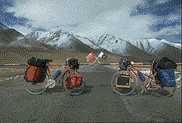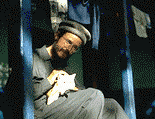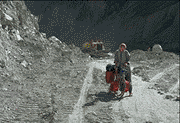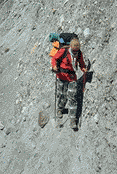

Robert Matzinger's Cycling Karakoram Highway Pages
This page evolved from various email-conversation with people all around the world. I simply compiled my answers to the most frequently asked questions into this page, which is therefore likely to grow in time:

 The Karakoram Highway connects Rawalpindi/Islamabad in Pakistan
with Kashgar in Xinjang/China. For that purpose it
has to cross/touch the highest mountain ranges of the world:
Himalaya, Hindu Kush, Karakoram, Khunlun and Pamir.
Starting from Rawalpindi it first crosses the northern part
of the Punjab lowland and the hills of Hazara, before descending
from a 1800m pass
into the Indus Valley, which it follows basically until Gilgit.
That's where the KKH turns into the Hunza Valley, which it follows
to its end before the Karakoram ridge is crossed by the Khunjerab Pass,
almost 5000m high. For the next time the KKH stays on high
Pamir range planes (never below 3000m), where there is another serious 4200m
pass before the Karakul lake is reached. After descending to the Tarim basin
via the Ghez gorge, Kashgar is reached.
See the
map
for details.
The Karakoram Highway connects Rawalpindi/Islamabad in Pakistan
with Kashgar in Xinjang/China. For that purpose it
has to cross/touch the highest mountain ranges of the world:
Himalaya, Hindu Kush, Karakoram, Khunlun and Pamir.
Starting from Rawalpindi it first crosses the northern part
of the Punjab lowland and the hills of Hazara, before descending
from a 1800m pass
into the Indus Valley, which it follows basically until Gilgit.
That's where the KKH turns into the Hunza Valley, which it follows
to its end before the Karakoram ridge is crossed by the Khunjerab Pass,
almost 5000m high. For the next time the KKH stays on high
Pamir range planes (never below 3000m), where there is another serious 4200m
pass before the Karakul lake is reached. After descending to the Tarim basin
via the Ghez gorge, Kashgar is reached.
See the
map
for details.
Please consider the following:
Doing the Karakoram Highway is still an expedition-like and
serious outing!!!
So this is definitely no tour for newbies.
There ARE serious dangers and risks you have to face, which can
be reduced (but not totally avoided) by experience and good
preparation.
Consider that we brought about 15 years of experience with cycling/traveling and we can also say that we are experienced alpinists/climbers. We highly recommend to bring PLENTY of experience with you, your partners, your equipment and your bike for this tour.

There is something we would urgently ask you for:
Please respect the VERY different culture of this country and not
even think of bringing short-armed t-shirts or shorts
(except to be worn under something).
However ANY clothing that covers the whole body except head,
hand and feet will be ok. Suitable clothing (called Shalwar Quamiz)
can be bought anywhere for a few rupies.
It's always tailored for you, so waiting about 24h is required.
This habit (as well as adopting to the culture in general) not only will make your journey more enjoyable (we made a lot of friends this way), but will make it a lot safer, as anybody will consider you as a guest. (See "Safety")

For female travellers we would recommend wearing a veil at least in the cities or when (many) poeple are around. There is no law that forces you to do that, but you will feel a lot better (and safer). However covering your hair is totally sufficient, there is no need to cover the face too.
Travelling without a male companion cannot be recommended for women, particularly not in Kohistan. In general the Pakistanis attitude with women is very different. Mostly they are polite and very generous, often shy, still their relation with women is sometimes felt a bit neurotic. The problem is that in the orthodox areas men normally don't see any women in their life, so they never learn to handle the presence of women. So expect at least to be glared at. However if you encounter any problems don't hesitate to protest loudly, get assistance or remember offendors how women in Pakistan normally are treated (i.e. with respect). Don't make good faces to things you don't like. Dare to be unfriendly from the beginning on. Violators of your private sphere will have a deep feeling of guilt. The ultimate gesture for showing contempt in case of distress is to wag with your shoe.
However let me note that we had only minor troubles of this kind (people glaring, people trying to enter our hotel room with odd excuses, just to get a glimpse on my wife,...) and we could easily solve them by refering to being married (in which case nobody could understand why we didn't have children, but anyway).

In general we would say that Pakistan is a relatively safe place to travel. There are certain areas that are not recommended to be travelled (mainly in Kohistan), but there will be no problem if you stay directly on the Highway. Don't hesitate to ask the local police about current conditions - they're mostly very friendly.
However there is one important principle we would like to emphasize:
Recall that you are travelling in an Islamic country, where many areas have adopted a quite archaic culture and the Afghanistan war is/was not far away. However there is the principle of the islamic guest law, which is very strict: As long as you behave "with honor" you will be treated like a guest. You may actually be protected by the people giving you refuge, because if something bad happens to you, this will bring the serious dis-honor of having violated guest-law to them. So when sleeping in the small villages e.g. in Kohistan, we often had the feeling that not only our Hotel-"wallah" was protecting us, but that the whole village were taking care of our safety. Behaving with "honor" includes (as we encountered it) politeness, appropriate clothing, acceptance of Islam and most important not to sleep in the wild without asking anybody, if there's a hotel within reach.
Note that on the other hand if you do NOT behave with honor
guest-law does not apply and you may be VERY unsafe.
Grades are often fairly steep too, however this is not the case for the
Khunjerab Pass: the pass is not so steep, just long.
On the Gilgit-Skardu road there is virtually no stretch
that is not a steep grade. And steepness is absolute extreme, as
this road was originally designed for military vehicles only.
All in all consider a decrease of your daily km's of about 30-50%
(In Europe we can usually do about 100km/day over some time,
in Pakistan we went 50-60 with the same effort).
If you cannot manage to get a flight to Kashgar, you would have to
use the bus to get there. In this case I would definitely recommend
Rawalpindi-to-Kashgar, because it must be very disappointing
(and will get out much of the thrill) to already have seen the
route from the bus window and then doing it slowly backwards.
However consider that, despite the fact that lots of tourists
are using the KKH, none of these buses ever stop in the tiny villages.
So you will still encounter a lot of spot's where people have no
experience at all with tourists.
Very seldom (but still) we were invited to private houses for an
overnight stay. I wouldn't dare to ask for it myself as (I think)
guest law forbids a negative answer.
IMPORTANT:
We use our now 15 year old traveling bikes which already survived several
tours all over Europe. They (and all the rest of the equipment)
were gradually enhanced during these years. For the KKH I took again a lot of
time and money to service the bikes and get them in shape.
We finally had
features like a third brake (very fine for the long
downhills and no need to carry any spare parts for the breaks anymore),
a frame enforcement (which was inserted 4 years earlier into my bike
to get rid of frame vibrations at high speeds), self-made paniers
of extra size (reasonably old, but in good shape),
the strongest 32-622-wheels we could get a hand on, etc.
for our disposal.
Most important, I know really every screw and every minor part of those
two bikes. So I know what they can take and how they can be repared. I
always took care for compatibility with the most simple and cheap
cycle spare parts (I would call our bikes low-tech) when buying parts.
And indeed we would have been able to get spare parts for this simple
technology in most of the major towns (still we carried 3.5 kg of
repair tools and spare parts).
You will be in trouble, if one of these ultimate doing-everything-alone
high-tech bike-parts
fails in the middle of a Chinese desert stretch.
That's why - in any case - I definitely recommend not to go with a
brand new bike. Every new bike (even the most expensive one)
has weaknesses you have to find out.
Know your bike in every detail, before you go!
Just a note on tires and flats: There is some plant in the
Kohistan and especially the Skardu area which spits thorns into the
sand. We had about twenty flats/punctures in this area, seven at a day
alone.
So take enough puncture repair stuff and spare tubes with you.
Further notes on equipment will be added on request.
Happy Cycling -
Robert Matzinger
© Copyright notice: All pictures and text in this site are mine.
Reading, viewing and enjoying is free, but distribution and publication
(in whatever form) requires
written permission of the author.
Annoyances
There ARE some annoyances along KKH. The most serious are:
A hint: Never try to cycle away from a dog.
We encountered a dog with only three legs who went 33 km/h. If you just
stop, dogs will (usually) not dare to attack you.
Health
Very important:
Care for your health.
 This is best done by caring what you eat. No reason for
paranoia, but follow the rule "bake it, cook it, peel it or forget it"
with no exception. We also strictly purified our water with our filter
(Catadyn). Still we got some stomach problems, but could cure them
ourselves with antibiotica our doctor gave us at home. So good
medical advice at home (and all the vaccinations) is mandatory.
For malaria we took nothing but long clothing and a
mosquito net for the night, which seemed to be plenty.
This is best done by caring what you eat. No reason for
paranoia, but follow the rule "bake it, cook it, peel it or forget it"
with no exception. We also strictly purified our water with our filter
(Catadyn). Still we got some stomach problems, but could cure them
ourselves with antibiotica our doctor gave us at home. So good
medical advice at home (and all the vaccinations) is mandatory.
For malaria we took nothing but long clothing and a
mosquito net for the night, which seemed to be plenty.
Road Info
Altitute and Grades
This is no sunday-tour, so even for the "flat" parts of the way expect
reasonable amounts of altitude to be climbed. From Rawalpindi to Gilgit
expect a couple of thousand meters alone.
Not to mention the Khunjerab pass itself.
All in all we climbed about 20000m altitude upwards on this journey.
Pavement
 Most of the KKH is paved. The same is true for the Gilgit-Skardu road.
However note
that "paved" on the KKH does not mean what it means e.g.
in Europe. Pavement is normally rough and washboard-like, not
to speak of holes.
You also have to expect unpaved landslide areas regularly, which
can be some km's long.
Most of the KKH is paved. The same is true for the Gilgit-Skardu road.
However note
that "paved" on the KKH does not mean what it means e.g.
in Europe. Pavement is normally rough and washboard-like, not
to speak of holes.
You also have to expect unpaved landslide areas regularly, which
can be some km's long.
Traffic
All in all traffic is sparse. Let me describe it from Rawilpindi to
Kashgar:
You will find heavy traffic on the grand trunk road leaving Rawalpindi,
but it's so broad, that we didn't find it dangerous (Trucks will
leave you 2m space). Then you can take secondary roads for a while
(don't miss Taxila !). After that until about Abottabad there is the most
inconvenient section with really lots of traffic on a narrow, hilly road.
After that traffic decreases more and more and from about Dasu you have the
road more or less for you.
In Hunza traffic is a bit more, but still no problem,
while it decreases
in China to about 10 vehicles per day.
Climate
You will go through any climate along the KKH. From 40 degrees Celsius
high humidity in
Rawalpindi to -15 degrees Celsius during the night around
the Khunjerab pass.
Consider this when packing sleeping bag and clothes.
However rainy weather is seldom, if you avoid the monsoon, so good
rain equipment is not so extremely important (but still useful).
Which time of the year is recommended
Calculate yourself! Here are some hints:
In summer it can get unbearably hot down in the Punjab and in Kohistan.
July and August are monsoon time with considerable rain being likely,
however it's quite frequent
that the monsoon is totally kept away from any area behind the
Himalayan range. In October usually the first snow falls at the
Khunjerab Pass, it is likely to be closed afterwards.
We did it in September/October so we avoided
the worst heat and still could cross the Khunjerab Pass before the winter.
However at the end of the journey it already got uncomfortably cold and
the lack of daylight reduced our daily km's considerably.

Take some Spare Time!
The KKH is a constant building site at some parts.
Nobody can say when it get's damaged/interrupted.
Being in hurry for reaching your plane might be unpleasant in such
a situation.
Four weeks is very short (yet sufficient) for making it to the
Khunjerab pass (by bike) and back (by bus). For going into China
I would consider two months at least.
Personally I recommend to plan to do a shorter stretch, to avoid to hurry,
as this would take out
the ultimate pleasure of spontaneously getting in contact with people
along the way.
Which direction? Kashgar to Islamabad, or the reverse?
That depends. Kashgar-Islamabad has the advantage, that you are up in
the mountains when it's still hot and get down to Rawalpindi when
it's conveniently cool there.
However the disadvantage is that you start with the remotest
section (i.e. China) and have to
go the long, long planes upwards, which might be very boring,
and then rushing the Hunza valley downwards, which is much more a
place to spend time on the details.
China
And now for China, which is a chapter for itself:

Food supply is ONLY in Kashgar, Tashkurgan and Sost, but not in between.
So you have to carry supply for about a week
(or more, if you do it upwards, i.e. Kashgar to Islamabad).
And finally something vital (not to be found in the Lonely Planet Guide):
Between Tashkurgan and the Karakul Lake you encounter a serious
desert stretch. Carry enough water there. Do fetch it in time!
Travelling in Pakistan
Very much different to China, everyone (even the officials) will help you
with any problem in Pakistan. Standard phrase is "No problem, Sir". This is
especially the case around Rawalpindi and in Hunza, not so much (but still) in
Kohistan and Baltistan. For receiving this hospitality it is important to
follow my earlier point (clothing, behaviour, ...), see
Safety.
A note on going up the Khagan Valley to Chilas
This is a frequently asked question.
However I cannot recommend to do that.
When we cycled the KKH I met several cyclists reporting horrible
stories about this area:
Whereas the situation on the KKH is much better
(see
"Traffic"):
Friendlier people,
the Police is in good control of the highway
(but not of the surrounding area!!! So don't leave the highway) and you have an entirely paved road
(with exception of some km's).
Equipment
I will definitely not write a lot about equipment, because poeple
who are very unsure about what to take with them should be adviced not
to try the KKH at all. However, here are some hints.
Do I need a tent?
 On the whole Pakistan area you cannot use a tent, even if you carry one.
It's considered bad habit not to take a hotel, so it is extremely unsafe
in Kohistan and still not very convenient in Hunza.
However, if you take hotels (very cheap), you are under the islamic
guest law, ... see
"Safety".
On the whole Pakistan area you cannot use a tent, even if you carry one.
It's considered bad habit not to take a hotel, so it is extremely unsafe
in Kohistan and still not very convenient in Hunza.
However, if you take hotels (very cheap), you are under the islamic
guest law, ... see
"Safety".
From Sost to the Khunjerab Pass and in the entire China section of the KKH
YOU ABSOLUTELY NEED a tent, because stretches
between accomodation are very much too far to be cycled in one day.
Villages are often very far apart and/or far away from the KKH, without a
road into it. In China it was for long forbidden to take foreigners into
the house and poeple are still acting this way. Mostly they are not so
friendly anyway.
Bikes
You may have seen our bikes on the title picture of the
 KKH Home page.
KKH Home page.
You definitely need a good, reliable bike. This needn't be a
mountain bike, actually I don't like mountain bikes for travelling
at all.
Weight
As we carried trekking equipment (like e.g. shoes, crampons, rucksacks),
foto equipment, a good set of spare parts, etc. we went quite loaded.
We had about 30 to 35 kg of package on our bikes, depending on
how many food we were forced to carry. This sums up with the bike to
a good 50kg per person.
Clothing
See
"Climate". Is there more to say?
Other equipment notes
Just a note on the stove, which you need for cooking
in remote places, because you
shouldn't expect to find firewood (and if so, please leave it
to the natives). Propan or butan gas stoves are not at all useful,
because you are normally not allowed to take them on the flight.
Get a good multi-fuel gasoline stove (we use an M.S.R. wisperlight
for several years), but bring the fuel bottle EMPTY for the flight.
You will have no difficulties to get gasoline along the route.
Trekking and Side Trips
 As you might know, trekking is actually the main business for
tourists in Pakistan. Most trekkers take a guide and some
porters, which is not hard to organize and not extremely expensive.
Still we prefered to go alone, but for long trips this would
be unreasonable.
We trekked into the Batura Valley, which was very nice.
However: Do not attempt to cross one of the big glaciers
on your own (i.e. without a guide), unless you are an EXPERIENCED alpinist.
(I think I am, here in Vienna I'm leader of a climbers club).
Beside that it was VERY beautyful, and it was nice to see people
live in the original fashion (i.e. without a street).
I would still like to do more trekking in the Hunza area
(LOTS of possibilities), because poeple are so friendly and
the landscape is amazing.
As you might know, trekking is actually the main business for
tourists in Pakistan. Most trekkers take a guide and some
porters, which is not hard to organize and not extremely expensive.
Still we prefered to go alone, but for long trips this would
be unreasonable.
We trekked into the Batura Valley, which was very nice.
However: Do not attempt to cross one of the big glaciers
on your own (i.e. without a guide), unless you are an EXPERIENCED alpinist.
(I think I am, here in Vienna I'm leader of a climbers club).
Beside that it was VERY beautyful, and it was nice to see people
live in the original fashion (i.e. without a street).
I would still like to do more trekking in the Hunza area
(LOTS of possibilities), because poeple are so friendly and
the landscape is amazing.
Further Info, Literature
There is a simple advice: Get yourself a
Lonely Planet
guidebook (this is no advertisement, but this book was indeed of incredible
value).
Conclusion
We did the whole KKH 1994 on the cylces and found it to be
the most worthwhile and impressive journey we ever
did. We got somehow in love with Pakistan and its people.
The landscape in
China is absolutely increcible, incomparable with anything
I have seen before.
So plan VERY carefully and do it, you will not regret.
(And drop me a mail if you did it.)
A Final Word
If you think that some important info is missing on this page or
you find something wrong or you have a question, don't
hesitate to contact me via
email at
matzi@kr.tuwien.ac.at.

 As more and more info should be added over the time, this page is
by its nature permanently under construction.
As more and more info should be added over the time, this page is
by its nature permanently under construction.
Navigation:
Last modified Feb. 97